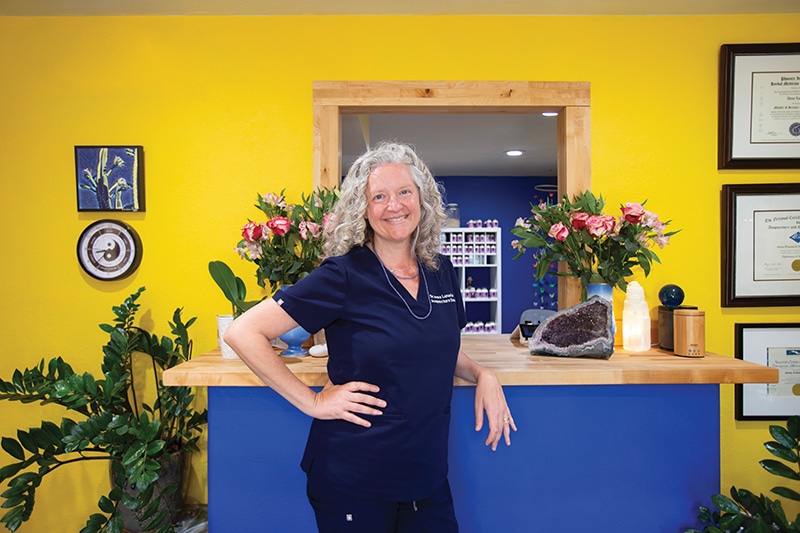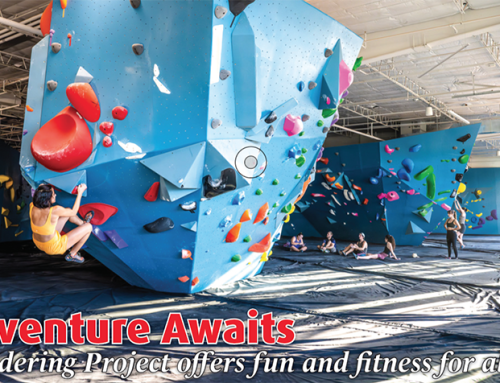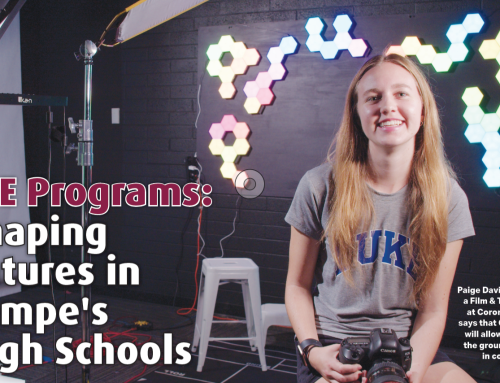By Shay Moser
Photos by Kimberly Carrillo
Dr. Anna Lunaria, who has scoliosis, had back pain from pinched nerves in adolescence. She suffered through it, getting no help from doctors or physical therapy. Then, at age 16, she discovered yoga for relief and has taught it since 1991. This personal healing path led her to become a massage therapist, acupuncturist, and hypnotherapist — and she’s blended and applied these holistic healing approaches to herself and countless patients for over 29 years.
Today, Dr. Lunaria runs Yin Rising Acupuncture in Tempe, offering orthopedics and sports medicine acupuncture and bodywork to relieve patients’ acute and chronic pain.
Twenty percent of Americans suffer from chronic pain and, like Dr. Lunaria, do not get relief from the allopathic medical system. Dr. Lunaria also treats many other health concerns — from anxiety and depression to chronic digestive issues and infertility — naturally with acupuncture and integrative medicine. Dr. Lunaria also offers longevity and facial acupuncture.
“Acupuncture is a natural medicine that is great for resolving many health concerns that seem treatment-resistant, bridging the gap in mainstream medicine,” says Dr. Lunaria.
“Although I treat an extensive range of things in the clinic daily, I specialize in helping people with chronic pain, whether it’s neck pain, back pain, shoulder pain, foot pain, hip pain, knee pain,” she says. “I especially love helping people who haven’t received help elsewhere.”
Before becoming a licensed acupuncturist, Dr. Lunaria would get acupuncture for everything massage and yoga didn’t help, including chronic migraines, nausea when she was pregnant, a hamstring strain from doing too much yoga, and a lingering cough after a cold.
“I decided to become an acupuncturist to provide people with an incredibly effective natural medicine for most health and wellness concerns,” she says.
To be a licensed acupuncturist in Arizona, you complete a master’s degree with over 3,000 hours of education and pass three National Board Exams. In addition, Dr. Lunaria has furthered her education by earning a doctorate in acupuncture and integrative medicine.
In 1998, she founded the Lunaria Wellness Institute, where she’s continued to deepen and broaden her experience and understanding of the human body and healing through teaching massage and anatomy. Dr. Lunaria has trained more than 1,500 hours of anatomy and has taught over 10,000 hours of yoga. This gives her a three-dimensional understanding of the human body.
Acupuncture 101 at Yin Rising
Eastern medicine, sometimes called Traditional Chinese Medicine, describes acupuncture as a technique for balancing energy or life force flow — known as chi or qi (chee) — believed to flow through pathways, or meridians, in the body. By inserting needles into specific points along these meridians, acupuncture practitioners stimulate nerves, muscles, and connective tissue to boost the body’s natural painkillers.
“We’ve learned a lot in the past 3,000 years about how acupuncture works from over 8,000 research studies,” Dr. Lunaria explains. “The first thing that happens when an acupuncture needle is inserted in the body is combustion of ATP. We eat calories, which the body turns into energy, or ATP. When this happens, Adenosine (A) splits off from TP (TriPhosphate). ATP combustion equals energy equals Qi. Free adenosine in the body is a natural sedative. This makes acupuncture very relaxing. Free adenosine is a vasodilator, increasing blood flow. Free adenosine is also a natural pain reliever. Adenosine also signals the immune system to decrease inflammation. And this is just the start of how acupuncture works to heal the body.”
Does acupuncture hurt? It shouldn’t!
The needles used by Dr. Lunaria are very thin, about as thick as a strand of hair.
“I always tell people acupuncture shouldn’t be painful,” she says. “When it’s done right, it should be relatively painless. You might only feel a slight pinch.”
If any needle is painful, Dr. Lunaria says she pulls it immediately.
“Being able to relax is part of the treatment,” she says. “Part of what we’re trying to do for any health condition is shift you out of the sympathetic nervous system into the parasympathetic or switch you from stress to relaxation mode. When we’re under stress, it makes all health problems worse.”
Your first appointment is usually about 60 minutes. Follow-up sessions are 45 to 90 minutes. Some conditions resolve quickly within one to three treatments if they are recent concerns. Any chronic condition (something you’ve had longer than one year) can take 10 to 20-plus treatments to resolve fully.
Dr. Lunaria explains, “All research studies looking into how and why acupuncture is effective always design treatment protocols using 10 to 12 treatments as a course of treatment, treating two to three times per week. This is what the ancient acupuncture masters documented in their writing, and modern science confirms it.”
“Acupuncture isn’t voodoo. It’s a physiological process,” she says. “One of the most fabulous things about acupuncture, and there is evidence that affirms this: After a course of acupuncture, most people experience up to a year of relief, and some people benefit from tune-up treatments.”
Yin Rising Acupuncture is located at 6101 S. Rural Rd., Suite 112, Tempe. Visit yinrising.com or call 480-206-6199 to learn more and book your acupuncture consultation.
This content is sponsored by Yin Rising Acupuncture.





